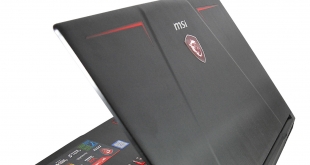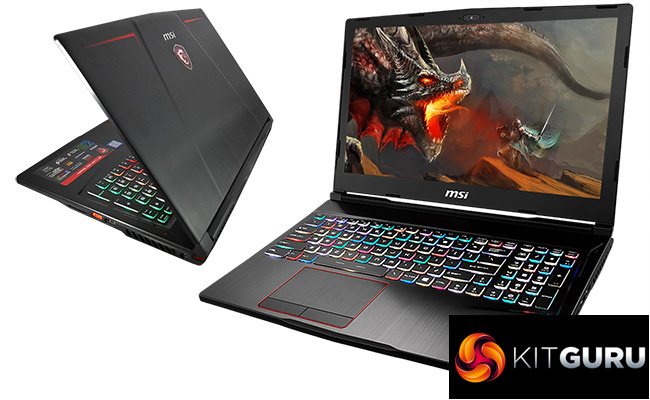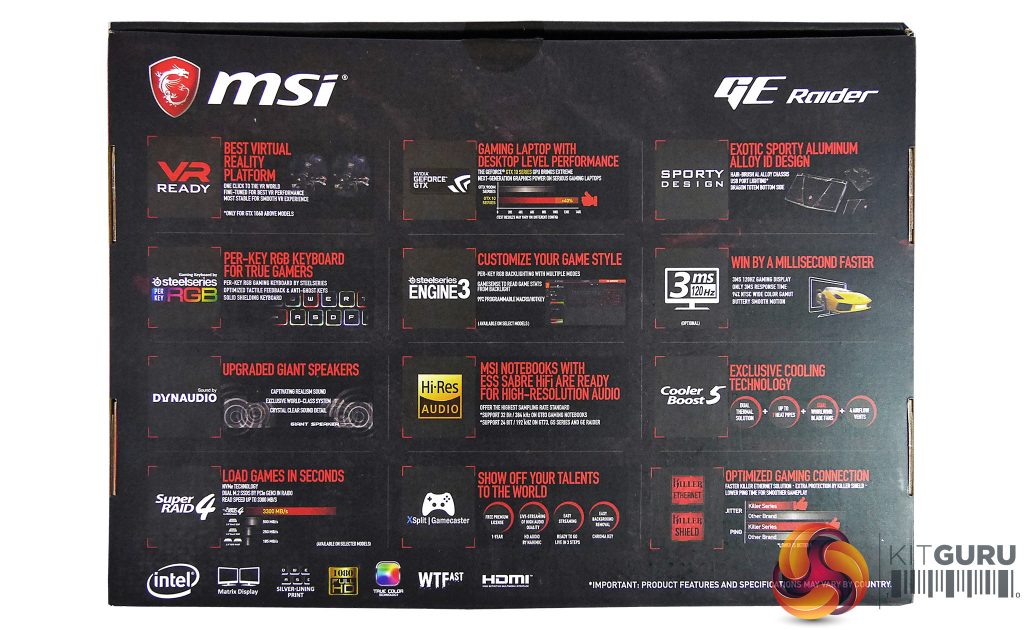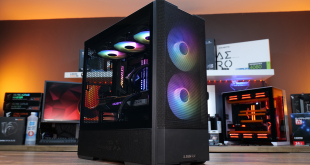
Another week, another red-accented RGB gaming laptop. But MSI’s new Raider series isn’t just a decent mid-range laptop with an RGB keyboard thrown in, like the Asus ROG Strix GL753VD we looked at recently. The Raider name stands for hardcore gaming, and even the lowliest member of the range which we’re looking at here brings some kick-ass specs to the table.
First an overview: there are several distinct models in the MSI GE Raider VR family, with the main differentiator being that all-important GPU. Our GE63VR 7RE (also known to his friends as “MSI GE63VR 7RE(Raider)-045UK”) starts off with a GeForce GTX 1060, the minimum mobile Nvidia solution that’s marketed as VR-capable. Next up is the 7RF model with a 1070, and several variations offering this card.
So with a relatively lowly GTX 1060, where do the hardcore gaming bits come in? Well, the GE63VR Raider 7RE’s 15.6in display sports a 120Hz panel with 3ms claimed response time and 100% sRGB “True Color 2.0” technology, which should make for smooth and hopefully good-looking gaming – as long as that 1060 can keep up of course.
Then there’s highlights like its Core i7 CPU, SteelSeries RGB gaming keyboard with per-key lighting, impressive Dynaudio speaker solution with twin woofers, ESS SABRE HiFi Audio DAC, USB LED lighting (yes really), Killer DoubleShot Pro Gb LAN, advanced Cooler Boost 5 system with dynamic control, and more.
Based on specs then, it seems MSI has done a good job of putting together a well-balanced mid-range system for the gamer on a somewhat limited budget. But as always the proof is in the pudding (or in this case, the metal-alloy and plastic chassis), so join us as see just how well this Raider can live up to its name.
MSI GE63VR Raider 7RE Specs
- OS: Windows 10 Home 64-bit
- CPU: Intel Core i7-7700HQ (7th gen), quad-core, 2.8-3.8GHz, 6MB cache, 35-45W TDP, socket 1440
- Memory (installed / supported): 8GB / 32GB DDR4 (16GB on our review model)
- Memory slots: 2
- Storage (main): M2 256GB SSD (Kingston RBU-sns8152s3256GG5)
- Storage (secondary): 1TB 7200RPM 2.5” HDD (Seagate BarraCuda ST1000LM048)
- Graphics card (integrated): Intel HD 630
- Graphics card (dedicated): Nvidia GeForce GTX 1060 (GP106), 6GB GDDR5
- Display (size, resolution, Hz, Type): 15.6″ (16:9), FHD (1920×1080), 120Hz, TN
- Touch support: no
- Keyboard type, design, backlit: membrane, chiclet, RGB backlit
- Connectivity (wireless)
Wi-Fi 802.11 AC (Killer)
Bluetooth V4.2
Connectivity (physical)
Audio: 1 x Microphone-in jack, 1 x Headphone-out/SPDIF jack
Data: 1 x USB 3.1 TYPE C port(s), 3 x USB 3.0 port(s)
Network: 1 x RJ45 LAN
Video: 1x HDMI 2.0, 1 x mini DP 1.2
Card: SD(XC/HC) - Optical drive: no
- Webcam: yes, HD
- Speakers: 2x 2W stereo, 2x 3W woofer
- Dimensions (WxDxH): 383 x 260 x 27.5 mm
- Weight: 2.39kg (with battery)
- Battery: integrated, 51Wh
- Warranty: 24 months (EU)
- Price: £1500 inc. VAT at time of review
 KitGuru KitGuru.net – Tech News | Hardware News | Hardware Reviews | IOS | Mobile | Gaming | Graphics Cards
KitGuru KitGuru.net – Tech News | Hardware News | Hardware Reviews | IOS | Mobile | Gaming | Graphics Cards





Why would anyone pay £1497 for this with a GTX 1060 when you can get a Gigabyte with an I7 and a GTX 1070 for £1499? https://www.overclockers.co.uk/gigabyte-p57x-v7-cf2-nvidia-gtx-1070-8gb-gddr5-17.3-fhd-ips-intel-i7-7700hq-gaming-laptop-lt-07s-gi.html
120Hz screen. 60Hz is cancer in comparison
I concur. Yet there is no point matching a GTX 1060 with 120Hz display. Unless medium settings is more appealing?
People chose 120hz for competitive gaming, not casual single player games because there is no point in there. Also no one use high settings in any competitive game like CS: GO, Overwatch, therefore 1060 can push 120 hz easily.